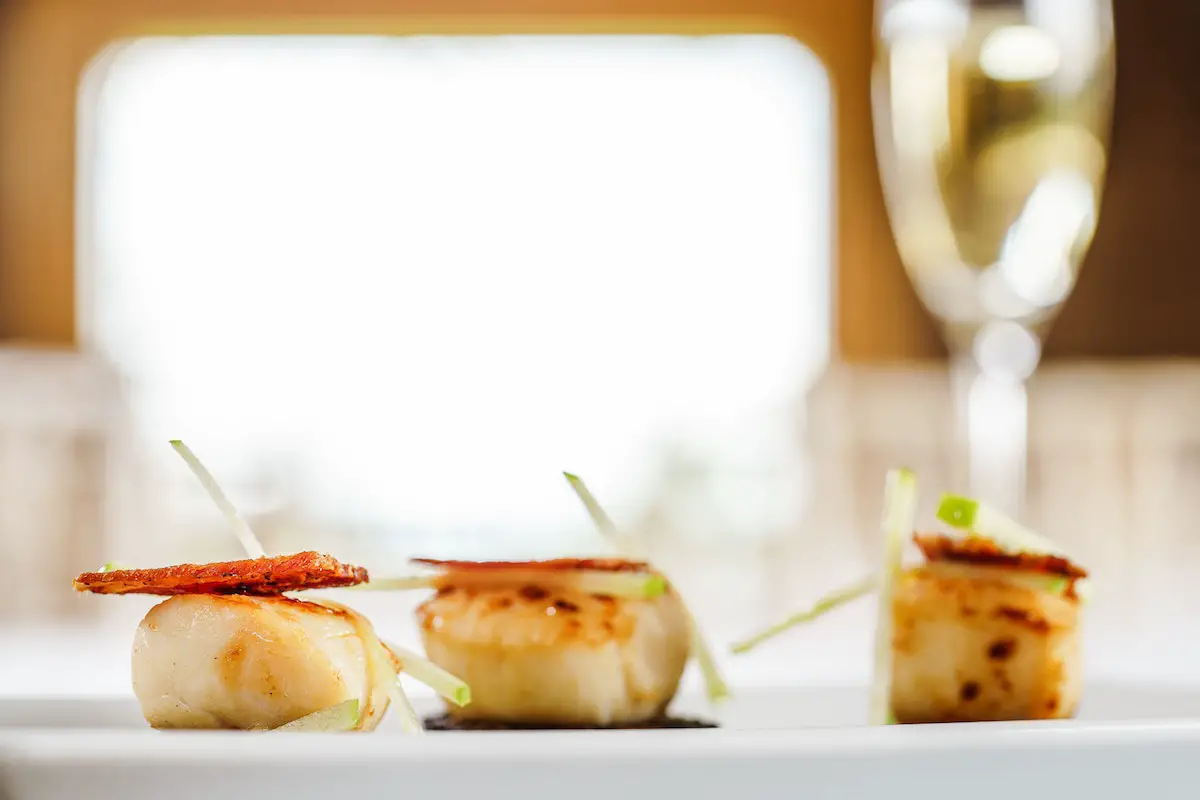Nominated-Day or Next-Day
Nominated-Day or Next-Day

Scallops can be eaten raw, but some precautions are essential. Ensure they’re freshly caught and stored on ice to prevent bacterial contamination. It’s best to enjoy raw scallops in specialty restaurants or prepared by a skilled cook.
Seafood enthusiasts know scallops as a prized delicacy, often featuring as a pricey menu item.
Scallops, a gourmet favorite, often come with a high price tag in upscale dining establishments. Typically served as a starter with just a few scrumptious pieces, their deliciousness makes every bite worthwhile.
Scallops are a type of shellfish, closely related to oysters, clams, and mussels. Two varieties are commonly consumed: the smaller Bay scallop found in estuaries and the larger sea scallop harvested from deep ocean floors. Bay scallops tend to be more affordable, but both command a premium price.
Living in fan-shaped fluted shells, scallops have round, mostly white, soft, and slightly translucent flesh. Unlike other shellfish with chewy textures and strong flavors, scallops have a sweet taste with a smooth, melt-in-your-mouth consistency and with a hint of fresh sea-like flavor.
Typically, scallops are seared in a hot skillet, resulting in a light caramelization on the outside. After cooking, their once-opaque flesh turns firmer and whiter. But can scallops be enjoyed raw, or should they always be cooked? Let’s find out!
Admittedly, raw scallops in their shells don’t look very appetizing with their unique, slimy, and gloopy appearance. However, it’s lesser known that scallops are among the few marine creatures safely consumed raw, offering a delightful flavor and considered a delicacy in specialized seafood restaurants.
Many sushi restaurants serve scallops as a raw seafood sashimi option. In other places, scallops are “cooked” lightly in acidic substances like lemon juice instead of being heated. It’s also common to enjoy scallops lightly seared, leaving the center uncooked.
Although scallops can be eaten raw, precautions must be taken to ensure their safety for consumption. Improper handling or preparation of shellfish can result in adverse health effects.
Two crucial factors to consider are that scallops must be freshly caught and properly cleaned and stored to prevent bacterial contamination. If these precautions aren’t followed, the scallop shell may break down, leading to bacterial infection and increasing the risk of food poisoning.
For this reason, it’s generally recommended to only consume raw scallops prepared by a specialized seafood restaurant that serves same-day caught scallops and can ensure their safety for consumption.
When enjoying scallops at home, it’s best to cook them before eating to minimize any risks!
One of the finest ways to enjoy raw scallops is when they’re freshly caught and savored right off the boat. Scallop fishermen often relish an uncooked scallop before heading back to shore.
Finding a restaurant that serves the right kind of raw scallops will provide a truly delightful experience.
So, what does “the right kind” mean, and what should you look for?
Scallops are caught in two ways – on day boats that return to the shore daily or on larger vessels that sail the seas for weeks and store their catch frozen.
Day boat scallops are considered the highest quality because they’re freshly caught, offering the best taste. When stored on ice, scallops slowly deteriorate and absorb moisture, resulting in a watery and unpleasant texture.
Additionally, seek restaurants that serve “dry” scallops, meaning they haven’t been soaked in preservatives.
If you find a restaurant offering these delicious fresh-caught, preservative-free scallops, you’re in for a treat!
Fresh scallops can be even more flavorful than cooked ones and have a subtle saltiness. The most accurate description of raw scallops’ taste would be like the aroma of a fresh ocean breeze!
Eating improperly stored raw scallops can expose you to various food-borne illnesses.
Food poisoning from raw scallops can cause severe digestive symptoms, such as diarrhea, vomiting, and abdominal pain.
Other symptoms may include painful skin irritations, headaches, itching, irregular heart rate, sweating, and even the risk of sepsis.
Reduce the likelihood of experiencing these issues, there are ways to minimize the risks associated with eating raw seafood:
Scallops that have been stored in ice for extended periods or soaked in preservatives will have a watery, fluid texture, akin to chewing the inside of a brine-filled balloon!
This is nothing like the soft, silky smoothness of a fresh, delectable day-caught scallop.
Scallop enthusiasts will tell you that the best way to savor them is freshly harvested, preferably at sea! Consumed this way, without any added flavorings or seasonings, they taste exquisite.
However, not everyone has the chance to embark on a scallop fishing adventure. So, how do you prepare and enjoy raw scallops while preserving their freshness?
First, ensure you’re using dry, day-caught scallops purchased from a reputable fishmonger. Other scallop types should be cooked, as they could be unsafe or unappetizing when eaten raw.
Top-quality raw scallops are often served with a light seasoning of extra-virgin olive oil, lemon juice, and a pinch of salt.
For a more luxurious experience, consider the Italian carpaccio-style preparation, which is a popular method for serving raw scallops.
This technique involves thinly slicing the scallops, creating semi-translucent shellfish pieces. Arrange the slices on a plate and drizzle them with a dressing.
Typically, the dressing is extra-virgin olive oil combined with an acidic component, such as citrus juice or white wine vinegar. Enhance the dressing with chopped herbs and other accompaniments like dill, capers, chilies, tarragon, and cherry tomatoes.
If the idea of raw scallops doesn’t entice you (understandably, raw seafood may not suit everyone’s taste), rest assured that cooked scallops are equally delectable!
The best way to cook scallops is by pan-searing. It creates a delightfully crispy crust on the exterior, perfectly complementing the soft, sweet interior.
Read also: How To Reheat Scallops – Essential Guide
Scallops should be cooked just enough, retaining a slightly uncooked center. Overcooked scallops become tough, chewy, and far from enjoyable.

Leave a comment